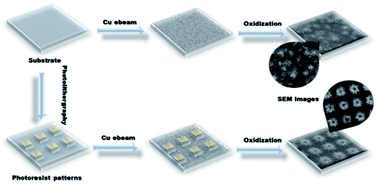Bioinspired hierarchical copper oxide surfaces for rapid dropwise condensation†
Abstract
Patterned copper oxide (CuO) microprotrusions have been developed by combining facile wet-chemical oxidation, photolithography and e-beam evaporation processes. The CuO microprotrusion was constructed from aligned CuO nanowhiskers, forming specific hierarchical structures. By adjusting the microfeatures of the photoresist and oxidation parameters, the geometry of the CuO microprotrusion can be finely tuned ranging from 15 to 25 μm, quite similar to that of a natural lotus leaf. The investigation of the surface wettability indicated that after fluorosilane treatment, the patterned surface presents remarkable superhydrophobic performance with contact angles over 160°. The in situ water condensation performance was tested and found to be highly dependent on the surface feature. The spontaneous removal of condensate droplets without the appearance of flooding can be realized when the microprotrusion has a diameter of ∼15 μm and an endowed cavity of ∼1.5 μm. Surface mapping could further verify the correlation of surface features with the nucleation, growth and departure of condensate water droplets. This bio-inspired condensate surface can find many potential applications in self-cleaning, anti-fogging, water harvesting and heat transfer-related fields.



 Please wait while we load your content...
Please wait while we load your content...